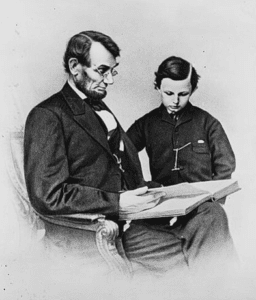Howard Fischer
Uppsala, Sweden

A brutal, bloody civil war had been tearing the United States of America apart for two years when President Abraham Lincoln arrived in Gettysburg, Pennsylvania on November 19, 1863. Four months before his visit, Gettysburg had been the site of a major battle between the secessionist Confederacy of the southern, slave-holding states and the armies of the Union, in which the Union had prevailed after a three-day battle. Lincoln was there for the consecration of the future National Cemetery at Gettysburg. His speech, famous for its eloquence and brevity, praised the men who fought and died to preserve the Union and its founding principles of liberty and “the proposition that all men are created equal.”
The day before his arrival in Gettysburg, Lincoln had complained of feeling weak on the train. On the day of the consecration, he felt weaker and looked “ghastly” according to observers. His symptoms progressed and he became febrile on the trip back to Washington. When he arrived, Lincoln remained febrile and began to develop headaches and back pain.
On November 21st a rash appeared, which progressed to blisters. The president’s physician diagnosed him initially with a cold, then malaria, and then scarlet fever. A consultant diagnosed “a mild case of smallpox.” On hearing the diagnosis, Lincoln remarked, “For once in my life as president, I find myself in a position to give everybody something.”
By November 27th the fever had decreased and the rash began peeling. Ten days later, Lincoln was able to walk short distances. A month later, he was said to have nearly all of his old energy back.
Goldman and Schmalsteig believe that Lincoln had a full-blown case of variola major—classical smallpox—which had a mortality rate of up to 30%. Their thinking is based on: 1.) the presence of a rash, 2.) an illness of three weeks duration, and 3.) the diagnosis of smallpox by the consultant physician. It is unknown if the president had ever received a vaccination against smallpox. The Lincolns’ son Thomas (“Tad”) had a febrile illness with a rash two weeks before his father’s symptoms began. In addition, the president’s valet and factotum, William H. Johnson, died of smallpox in mid-January, although there were others who could have been the source of his illness.
The US, deep in a war that threatened the integrity of the country, had the good fortune to have its commander-in-chief speak at Gettysburg and then survive a deadly disease.
References
- Mark Pallen. The Last Days of Smallpox: Tragedy in Birmingham. Independently published. 2018.
- Armond Goldman and Frank Schmalsteig, “Abraham Lincoln’s Gettysburg Illness,” J Med Biog, 15, no. 2 (May 2007);104-110.
- Michelle Ziegler, “contagions.wordpress.com,” December 20, 2009.
HOWARD FISCHER, MD, retired as a professor of pediatrics from Wayne State University School of Medicine, Detroit, Michigan. He is the co-editor of a textbook, Child Abuse and Neglect, and has had a long-term interest in the interaction of disease, medicine, and society.
Highlighted Vignette Volume 13, Issue 2– Spring 2021 and Volume 13, Issue 3– Summer 2021

Leave a Reply